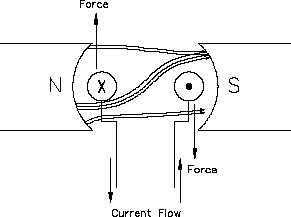DC Motors
DC MOTOR THEORY
Above the conductor on the right, the field caused by the conductor is in the same direction as
the main field, and therefore, aids the main field. Below the conductor on the right, the field
caused by the conductor is in the opposite direction of the main field, and therefore, opposes the
main field. The net result is that above the conductor the field is strengthened, or flux density
is increased, and below the conductor, the field is weakened, or flux density is decreased. A
force is developed on the conductor that moves the conductor in the direction of the weakened
field (downward).
In a DC motor, the conductor will be formed
Figure 3 Motor Action
in a loop such that two parts of the conductor
are in the magnetic field at the same time, as
shown in Figure 3.
This combines the effects of both conductors
to distort the main magnetic field and produce
a force on each part of the conductor. When
the conductor is placed on a rotor, the force
exerted on the conductors will cause the rotor
to rotate clockwise, as shown on Figure 3.
You can think of these magnetic lines of force
as rubber bands that are always trying to
shorten themselves. The lines of force above
the conductor exert a downward force due to
the magnetic lines of force trying to straighten themselves.
The above explanation of how a
Figure 4 Right-Hand Rule for Motors
force is developed is convenient;
however, it is somewhat artificial.
It is based on a fundamental
principle of physics which may be
stated as follows:
"A current-carrying conductor in a
magnetic field tends to move at
right angles to that field."
Another important way to show
the relationship between the
current-carrying
conductor,
magnetic field, and motion, is the
right-hand rule for motors, as
shown in Figure 4.
Rev. 0
Page 3
ES-06




